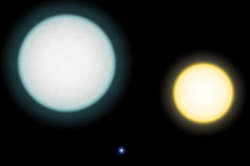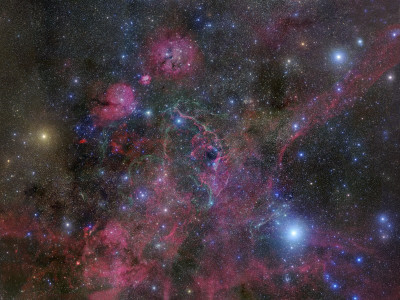dougettinger wrote:I am still confused. I thought O7 dwarfs came from intermediate mass stars (1 to 8 Msolar). O7 dwarfs are very recently evolved white dwarfs that are still very bright. But yet previously mentioned O7 dwarf's progenitor is a star of about 30 solar masses. How is this possible ?
It is the terminology that is the problem, not the stars themselves.
A dwarf star is a star that is fusing hydrogen to helium in its center. The Sun is a dwarf star. Sirius, which is much bigger than the Sun, is nevertheless a dwarf star, because it is fusing hydrogen to helium in its center.
But Sirius B is a "white dwarf star". The term is unfortunate. The term was coined, or so I believe, before the word "dwarfs" became the normal word to describe stars of any mass that are fusing hydrogen to helium in their centers.
Back when Sirius B was first detected, astronomers knew that "red dwarfs" existed. The red dwarfs were so called because they were redder than the Sun and much fainter. These dwarfs had to be cooler as well as smaller than the Sun in order to be so faint. At this time, astronomers also realized that a number of well-known reddish stars such as Betelgeuse, Antares, Aldebaran and Arcturus had to be very large, since they were so cool and yet so luminous.
When astronomers detected Sirius B, they didn't know what kind of star it was. They didn't realize that Sirius B is the still hot but cooling core of a dead star, a star which is no longer producing energy, but merely radiating away heat that was produced before. Sirius B produced heat both when it was a main sequence star of class B, fusing hydrogen to helium in its core, and then when it was a red giant, fusing helium to carbon and oxygen in its core and fusing hydrogen to helium in a shell outside its core. The heat that was built up during these energy-producing phases is now slowly radiating away into space as the dead core cools.
As I said, the astronomers that discovered Sirius B didn't know what kind of star it was, but they could see that it was very hot and very faint. Back then, no stars were described as blue, even though stars that are hotter than 20,000 degrees Kelvin are certainly bluish in color. To the astronomers who discovered Sirius B, the color representing the hottest stars was white. And so, because Sirius was very small and hot, it was described as a "white dwarf".
This has unfortunate consequenses. Personally I'm always going to argue that the Sun is white, because if it wasn't, then daylight, which is sunlight, wouldn't be neutral in color. If the Sun is really yellow, then we ought to see daylight as yellow. Since we don't, I'm always going to say that we should describe the Sun as white.
So if we accept that the Sun is white, and if we accept that a "dwarf" is a star that fuses hydrogen to helium in its core, then the Sun really ought to be called a "white dwarf". But the Sun is extremely different from what astronomers mean when they say "a white dwarf".

This image shows IK Pegasi, an A class dwarf, smaller and a bit cooler than Sirius, on the left, IK Pegasi B, a white dwarf, in the middle, and the Sun on the right.
As I said, I regard the Sun as white. But if we accept the established wisdom, which says that the Sun is yellow and A-class stars like Sirius and IK Pegasi are white, then, since both Sirius and IK Pegasi fuse hydrogen to helium in their cores, these two stars are both "white" "dwarfs" orbited by "white dwarfs"!
And if the hottest stars are described as white, then the Sun, which is clearly yellower than the hottest stars, will be described as yellow. Yellowish stars like Arcturus will be described as red, since they are redder than the Sun, which is "defined" as yellow. Really red stars, which are so small and faint that they only emit red light, will be described as "brown", since the term "red dwarf" is already taken.
To describe the Sun as a "yellow dwarf" is doubly unfortunate, in my opinion. It creates the idea that the Sun is yellow, which it isn't, in my opinion. And it creates the idea that the Sun is a very small star, when in fact it is bigger than most other stars, since most other stars are small class M stars, so called red (but really yellow-orange) dwarfs.
This picture shows you stars of various colors:
On the far left is Alpha Centauri, a main sequence star of spectral class G2. Alpha Centauri resembles the Sun, and in this picture it is appropriately white in color.
In the middle of the picture is the Southern Cross. The topmost star of the Southern Cross is Gacrux, a red giant star of spectral class M, which is yellow-orange in color. There are also many blue stars in the picture, and almost all of them are of spectral class B.
As for the term "white dwarf", it should be replaced with the term "degenerate star" or something, to point out that this is a star which has shrunk to an incredibly small size after all fusion processes have ceased in it. In a white dwarf, the atoms are packed so closely that only the so called "electron pressure" prevents the star from shrinking further.
Ann




